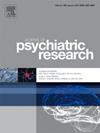情感障碍-精神病谱系中各种疾病的神经生物学相关性。
IF 3.7
2区 医学
Q1 PSYCHIATRY
引用次数: 0
摘要
情感障碍-精神病谱系中的各种疾病,如重度抑郁障碍(MDD)、双相情感障碍(BD)、分裂情感障碍(SCA)和精神分裂症(SCZ),都有症状重叠的现象,而且与其他精神障碍的合并率很高。然而,迄今为止,人们基本上还不清楚为什么有些患者会出现合并症。尤其是,人们对合并症的具体遗传结构及其与大脑结构的关系仍然知之甚少。因此,我们对临床、遗传学和脑结构测量进行了系统分析,以进一步了解精神障碍合并症的神经生物学相关性。我们对马尔堡/明斯特队列研究(MACS)的一个子样本进行了调查,该子样本包括被 DSM-IV-TR 诊断为情感障碍-精神病谱系中单一障碍的患者(SD,n = 470,MDD;BD;SCA;SCZ),以及其他精神障碍合并症患者(COM,n = 310)和健康对照组(HC,n = 649)。我们研究了以下方面的组间差异:a)总体严重性指数(基于 SCL90-R);b)利用大型精神障碍全基因组关联研究的汇总统计数据,以 PRS 连续收缩法(PRS-CS)计算的跨障碍多基因风险评分(PRS);c)全脑灰质体积(GMV)。各组之间的 SCL90-R 评分存在明显差异(COM > SD > HC)。虽然SD和COM在跨障碍PRS和GMV方面没有差异,但SD和COM与HC相比,在双侧岛叶、左颞中部、左下顶叶和几个额叶中显示出跨障碍PRS增加和GMV减少。因此,我们的研究结果表明,情感障碍-精神病谱系中的疾病无论是否有其他合并症,在自我报告的临床数据上都存在差异,但在遗传或大脑结构层面上却没有差异。本文章由计算机程序翻译,如有差异,请以英文原文为准。
Neurobiological correlates of comorbidity in disorders across the affective disorders-psychosis spectrum
Disorders across the affective disorders-psychosis spectrum such as major depressive disorder (MDD), bipolar disorder (BD), schizoaffective disorder (SCA), and schizophrenia (SCZ), have overlapping symptomatology and high comorbidity rates with other mental disorders. So far, however, it is largely unclear why some of the patients develop comorbidities. In particular, the specific genetic architecture of comorbidity and its relationship with brain structure remain poorly understood. Therefore, we performed systematic analyses of clinical, genetics and brain structural measures to gain further insights into the neurobiological correlates of mental disorder's comorbidity. We investigated a sub-sample of the Marburg/Münster Cohort Study (MACS), comprising DSM-IV-TR diagnosed patients with a single disorder in the affective disorders-psychosis spectrum (SD, n = 470, MDD; BD; SCA; SCZ), with additional mental disorder's comorbidities (COM, n = 310), and healthy controls (HC, n = 649). We investigated group differences regarding a) the global severity index (based on SCL90-R), b) a cross-disorder polygenic risk score (PRS) calculated with PRS-continuous shrinkage (PRS-CS) using the summary statistics of a large genome-wide association study across mental disorders, and c) whole brain grey matter volume (GMV). The SCL90-R score significantly differed between groups (COM > SD > HC). While SD and COM did not differ in cross-disorder PRS and GMV, SD and COM versus HC displayed increased cross-disorder PRS and decreased GMV in the bilateral insula, the left middle temporal, the left inferior parietal, and several frontal gyri. Our results thus suggest that disorders in the affective disorders-psychosis spectrum with or without additional comorbidities differ in self-reported clinical data, but not on genetic or brain structural levels.
求助全文
通过发布文献求助,成功后即可免费获取论文全文。
去求助
来源期刊

Journal of psychiatric research
医学-精神病学
CiteScore
7.30
自引率
2.10%
发文量
622
审稿时长
130 days
期刊介绍:
Founded in 1961 to report on the latest work in psychiatry and cognate disciplines, the Journal of Psychiatric Research is dedicated to innovative and timely studies of four important areas of research:
(1) clinical studies of all disciplines relating to psychiatric illness, as well as normal human behaviour, including biochemical, physiological, genetic, environmental, social, psychological and epidemiological factors;
(2) basic studies pertaining to psychiatry in such fields as neuropsychopharmacology, neuroendocrinology, electrophysiology, genetics, experimental psychology and epidemiology;
(3) the growing application of clinical laboratory techniques in psychiatry, including imagery and spectroscopy of the brain, molecular biology and computer sciences;
 求助内容:
求助内容: 应助结果提醒方式:
应助结果提醒方式:


